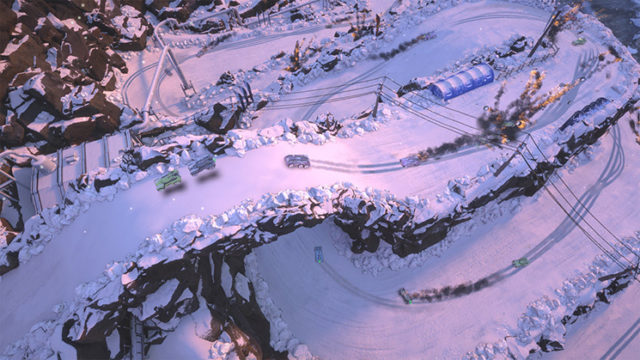It looks good; the career structure is unique and interesting; upgrade system allows for great customization; supports cross platform multiplayer; the option to mute the music.
Unlocking new maps, modes, and vehicles is a boring slog; early vehicles are frustratingly slow; main menu theme is horrible; low track count and lack of variety leads to lots of repetition.
As of right now, Switch could really benefit from more racing games. Mario Kart 8 Deluxe remains the best and most well-known representation of the genre on the system, but some smaller developers are starting to fill in the remaining void; Mantis Burn Racing from VooFoo Studios is one such racer. However, just because there aren’t many games of a particular genre on a system, it doesn’t make every example instantly worth playing.
Mantis Burn Racing is an arcade-style racing game featuring a top-down perspective, something that will likely make it stand out for many old-school gamers. Camera angles aside, however, the game is not simply trying to be a retro revival as everything else about it, from its features to its visuals, represents an obvious attempt to make something more ambitious. This approach is most evident in its rather robust career mode, which is spread across nine seasons divided into three subsets marked by a progression of increasingly more powerful and capable garages of vehicles. Each season presents a relatively linear set of events you’ll need to complete to move on; however, splits in the pathway of events give you some freedom to select which events you want to proceed with. Completetionists will, of course, want to take the time to complete every event, as will those who want to make the most of the game’s upgrade system. Ultimately, your goal with each season is to collect enough Gears to unlock the final event you need to complete in order to move on to the next season. Gears are awarded not just for completing events, but also tackling three optional side missions that are included in each event that will have you trying to drift more, catch extra air off jumps, finish laps under a certain time, or complete other challenges.
The aforementioned upgrade system is also a very strong feature that works in Mantis Burn’s favor. Upgrades are received by completing certain career events and earning experience awarded at the end of each race based on your jumps, drifts, passes, and other feats of driving excellence. As your experience bar progresses, you’ll be given new upgrades and level up, which then lets you purchase new vehicles. Once you buy a car with money earned through races, you’ll initially be able to attach three upgrades to it before having to drop some extra cash to level it up and open up more upgrade slots. This system is made all the more nuanced by the inclusion of three weight classes of vehicles, each with distinct advantages and weaknesses that will be familiar to anyone who has ever played a Mario Kart game. Over the long run, this gives you a lot of freedom in how you choose to customize your car, but you’ll want to be very careful to balance key stats like overall speed, acceleration and grip, as putting too much power into a car that can’t hold onto the road will almost certainly result in a hard to handle car and a lot of frustrating losses.

While Mantis Burn presents an interesting approach to progression, the core gameplay can’t manage to keep up. The moment to moment racing is perfectly okay, with generally responsive controls that are occasionally marred by a sensation that your cars feel far too light; this might help facilitate the drift-happy nature of the racing, but sometimes it manifests itself in the form of wonky collisions that seem to randomly stop you dead in your tracks or send you careening about wildly with little consistency. More times than not, though, the game feels okay and the controls are simple enough to make the game very easy to pick up and play.
What ultimately hurts Mantis Burn the most is how slowly it doles out new content. While the structure in the career mode is great in theory, it ultimately feels incredibly repetitive as you constantly find yourself revisiting the same few tracks over and over again. A total of twelve tracks are in the game, but they are introduced at a snail’s pace, and even though the game tries to counter this by having you run circuits both ways, that sense of sameness remains ever present. Several different race modes are also used to try to counteract the repetition, but they still remain so thoroughly rooted in the same core mechanics that it does little to help. Furthermore, the game is severely hurt by how incredibly slow and boring the early seasons are, especially events that force you into the heaviest class of vehicles which take roughly forever to attain a level of speed even remotely relatable to the concept of fun. Newer, faster sets of cars are unlocked over time and they make the game more fun, but in order to reach them you’ll have to spend far too long with races that are frustrating.
Thankfully, the game includes two extra seasons unlocked from the beginning, Elite and Battle. Elite races feature super fast and slippery hover vehicles that are instantly more fun than the molasses machines featured at the start of the standard career and Battle events feature more middle-of-the-road vehicles equipped with guns and mines used to blow away the competition as you race. Having access to these extra events helps alleviate some of the boredom, but there are fewer events in these seasons than the others, and large chunks of them are still gated behind large Gear counts that will require you to spend time with the normal career seasons. Considering all of this, multiplayer might be the best way to enjoy the game, but even that is slightly marred by the fact that full lobbies were very hard to come by despite the fact that the game supports cross-platform play with PC and Xbox One. Thankfully, local split screen is supported.

A rather surprising let down in Mantis Burn is how the game sounds. The sound effects are best described as anemic: whether you are playing docked or in portable mode, your revving engine and squealing tires sound like they were recorded on a cheap microphone and played through tiny speakers a million miles away. The soundtrack doesn’t fare much better thanks to the menu music which I found absolutely unbearable. This track, which you will hear frequently as it is the only song that plays outside of races, is a repetitive, droning mess of cheap synth sounds that really doesn’t even feel like it fits the game’s tone. The music in races fares better as it is generally more energetic and better fits the game, but it never rises above mediocrity and eventually became absent for me when I muted the game’s music in order to avoid that horrendous main menu theme.
Visually, Mantis Burn does redeem itself rather well. When viewing your vehicles in the garage, you will likely notice the flat textures and low polygon counts, but once you are actually in a race, the top-down perspective does wonders for the game. From this view, the levels look quite nice, with lots of little details in the environments including some nice lighting and solid art direction. The fact that the levels are limited to three general themes (desert, city, and snowy tundra) does contribute slightly to the general theme of repetition, but each track has its own unique touches to help alleviate some of that. Mantis Burn also runs quite smoothly as I only noticed a few brief hiccups in the frame rate during my time with it.
Mantis Burn Racing is an incredibly frustrating game. An overview of the game reveals a lot of promise thanks to its solid visuals, rewarding upgrade system, and interesting career structure. However, once you actually start racing, things begin to fall apart; your first few events will be fun but you’ll quickly realize how the content is spread thin and you have a long way to go before you’ll get to experience something new and fun. In other words, there’s some good stuff buried in Mantis Burn, but getting to it is a real slog, thus making hard to recommend for all but the most hardcore of racing fans desperate to relive the top-down experiences of yesteryear.
Nintendojo was provided a copy of this game for review by a third party, though that does not affect our recommendation. For every review, Nintendojo uses a standard criteria.




 ShareThis
ShareThis





